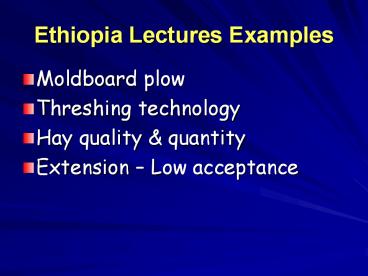Ethiopia Lectures Examples - PowerPoint PPT Presentation
1 / 19
Title:
Ethiopia Lectures Examples
Description:
Ethiopia Lectures Examples Moldboard plow Threshing technology Hay quality & quantity Extension Low acceptance Example #4 Extension Low acceptance Design ... – PowerPoint PPT presentation
Number of Views:76
Avg rating:3.0/5.0
Title: Ethiopia Lectures Examples
1
Ethiopia Lectures Examples
- Moldboard plow
- Threshing technology
- Hay quality quantity
- Extension Low acceptance
2
Example 4
- Extension Low acceptance
3
Design ProcessProblem Identification
- Engineered developments are difficult to market
through the current extension effort thus new
delivery methods are needed which will education
(why) and explanation (how) of new engineered
technologies.
4
Design Process
5
Project Definition and Description
- Design Topic specific topic which is
descriptive of this project - Design Purpose describe the engineering
problem, with current products or problems
explained - New delivery methods which will education (why)
and explanation (how) of new engineered
technologies
6
Project Definition and Description
- Define the functional requirements/constraints of
the process, device and/or system. The
functional requirements or specifications
(deliverables) define what the system will do and
how well it must do it. Design constraints
determined for the project. - Why current method is not accepted
- Improve the credibility of the transfer
- Limited resources and educational level
- Farmer involvement about best methods to receive
- Must be regional and universally accepted
- Cant be individual but in groups and/or
self-directed - Design Challenge - What specifically is new about
what is being proposed? Design new transfer
methods
7
Project Definition and Description
- Does a solution currently exist?
- What research has be performed to determine this
solution? If yes, describe. From the previous
results give some trends or details Be specific
types of extension delivery systems and impact on
audience awareness and acceptance of new
material - Describe any part of the project that cannot be
clearly defined.
8
Design ProcessGathering Data
- Gathering data
- Historical experience
- New ideas professional meeting
- Farmer ideas advisory group
- Experts all creative persons enjoy a challenge
- Web/Books/Factsheets Journal of Extension,
Building Community, Educating Adult Populations - Other disciples National Ag Agents Assoc
9
Design ProcessGathering Data
- What is available?
- New teaching method?
- What other delivery?
- Substitute materials - TV
- What do others use?
- How have farmers changed?
- Should the unit be design for specific
populations (20-40 years) or general populations? - Specific conditions to receive information and to
make changes - Match with other programs to move a forum in
front of the farmer. - Delivery methods what tried true? What has
worked and why?
10
Design ProcessCreating Ideas
- The Art of Engineering
- Creativity (step beyond the existing solution)
- Experience history (learned?)
- Out sourcing
- Farmer input (if shown exists, comments)
- Consultants (?)
- Looking for a large set of concepts to pull from
- How many? At least 3-5 concepts
11
Design ProcessPrepare Models
- Model community action groups
- Developing listening groups
- Observe other programs
- Using competitors systems (TV)
- How does a farmer change?
- How does a farmer adapt new ideas?
12
Design ProcessPrepare Models
- Modeling Factors
- Use post pre-test
- What is being adapted?
- When is the teachable moment
- Extension personnel involved in research
development - Cost?
- Acceptance?
- Other factors?
13
Design ProcessEvaluation
- Analyze options
- Develop Decision Matrix
- Select best option for full experimentation
- What are the most important criteria for testing?
- What will set your design apart from
state-of-the-art?
14
Design ProcessExperimentation
- What are the basic variables
- Change of attitude
- Energy commitment level
- Cost?
- What are the co-variants
- Age groups
- Need or problem not perceived
- Opposed to new ideas
- Timing
15
Design ProcessRepeat?
- What did the experiments tell you
- What new obstacles need to overcome
- Select a new concept?
16
The Engineering Method
Problem
Problem
Feedback
Feedback
Repetition
Solution
17
Design ProcessScientific Comparison
- Compare to state-of-the-art current delivery
system - Controlled conditions
- Willing to learn adapt
- Timing is appropriate
- Design of Experiment (pre/post)
- Null Hypothesis new concept is same as
conventional method - Measurements?
- Awareness, understanding
- Change of practice (adaptation)
- cost
18
Design ProcessMarketing
- Compare to state-of-the-art
- Highlight results
- Listening sessions
- Marketing evaluation (what is working?)
- Have some farmers present the material (so they
understand) - Brochures discussing merit
- Discuss farmer successes!
- Outcomes
- Faster adaptation (improved life)
- Change of attitude
- Confidence in the engineered devices
19
Design Process
- Highly challenging environment
- Must be willing to fail
- Make sure you do not have underlying assumptions
that hinders innovation - Try new ideas
- Always show the state-of-the-art with your
solutions - Have a good feel what incremental steps that
farmers are willing and can take































